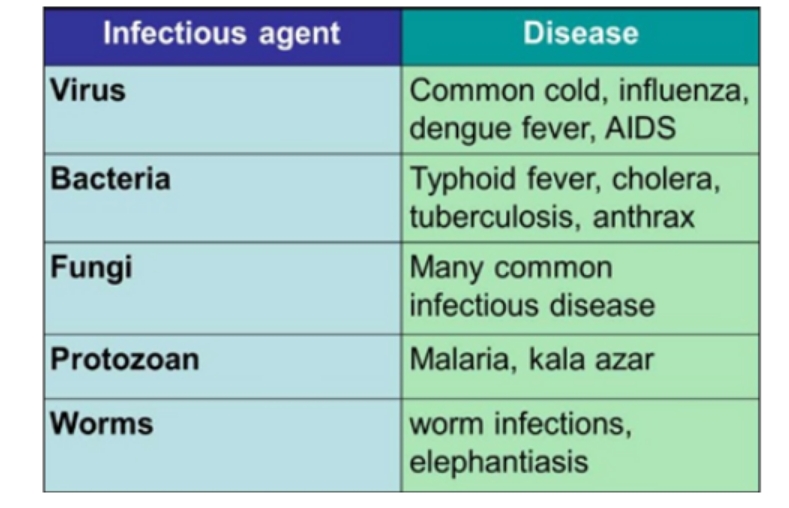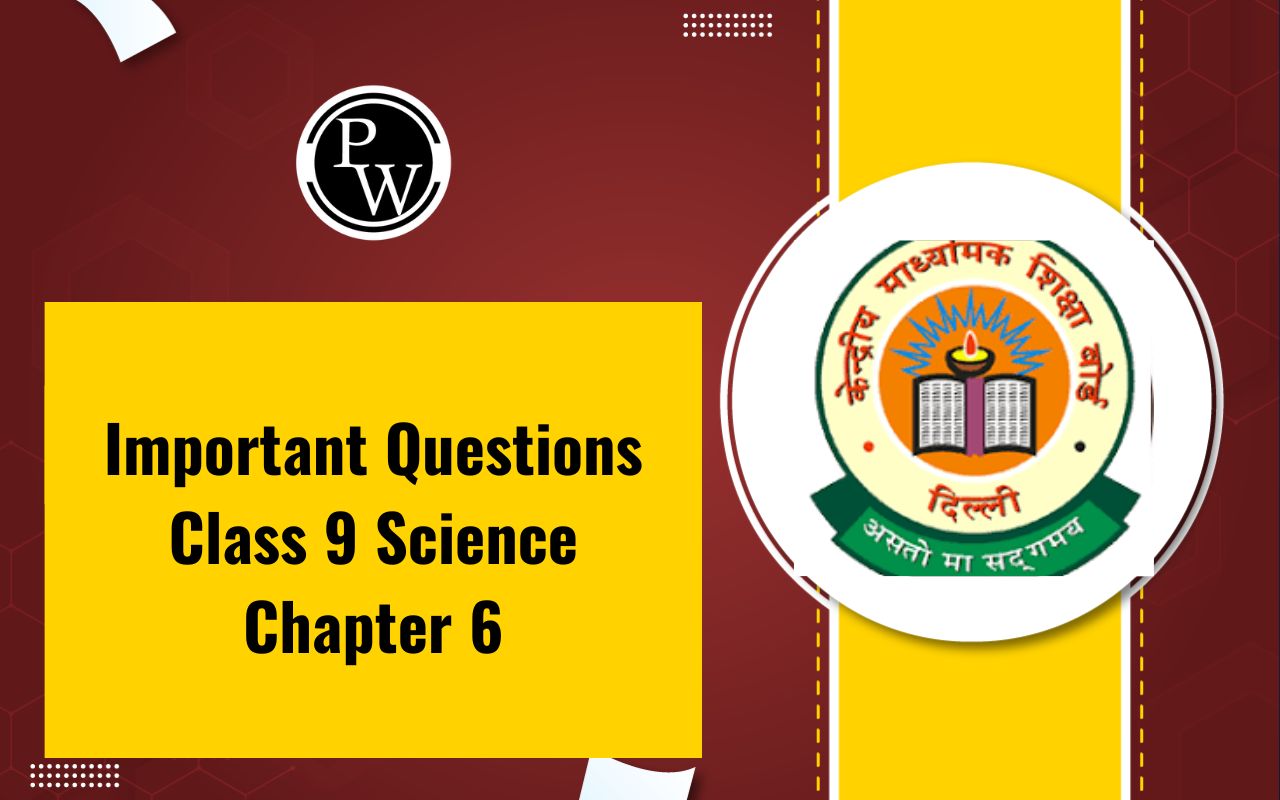
CBSE Class 9 Science Notes Chapter 13: A person is considered to be in good health when they are mentally, socially, and physically well—not just when they are free from illness or disability. A person in good health is not only physically strong but also cognitively quick. A person's living environment has a direct impact on his or her health. To stay healthy, one should therefore take care of his surroundings and keep them free of pollutants.
Most critically, though, food is essential to our development and growth, as noted in the CBSE Class 9 Science Notes Chapter 13. The CBSE Class 9 Science Notes Chapter 13, explains the causes of our illnesses and how they are all connected to either our environment, our nutrition, or both.CBSE Class 9 Science Notes Chapter 13 Overview
A state of total well-being that encompasses social, mental, and physical well-being is called health. A person's surroundings have an impact on their health in addition to themselves. It is impossible to go about daily tasks and perform adequate bodily, mental, and social functioning when one's health is compromised. The importance of health, different diseases, their kinds, causes, modes of transmission, manifestation, prevention, immunization, and treatment will all be covered in this CBSE Class 9 Science Notes Chapter 13.CBSE Class 9 Science Notes Chapter 13 PDF
Here we have provided CBSE Class 9 Science Notes Chapter 13 for the ease of students so that they can just download the pdf and use it easily without the internet. These CBSE Class 9 Science Notes Chapter 13 will help students understand the chapter better.CBSE Class 9 Science Notes Chapter 13 PDF
CBSE Class 9 Science Notes Chapter 13
Health
Health is a complete state of physical, mental, and social well-being. A person's total state of physical, mental, and social well-being. The body will not function properly if anything causes the proper operation of cells and tissues to be disrupted. Community and personal difficulties are significant contributors to health. ii. Every organism's state of health is dependent on its surroundings or environment. The physical environment is a part of the environment. A person's health is also greatly influenced by their social surroundings, public sanitation, stable employment and financial circumstances, social equality, and consensus.The Immune System
The body's defense mechanism against infection by microorganisms, foreign substances infiltrating the body, and other poisons is the immune system. Certain specialized cells, such as macrophages and lymphocytes, serve to limit the number of germs in our body by eliminating them when they enter. We are less prone to infections if our immune systems are functioning well; on the other hand, we are more susceptible to illnesses if they are not. This explains why certain kids are more likely than others to contract illnesses. Therefore, healthy nutrition is essential for the immune system's optimal operation as well as the prevention of infectious diseases. After primary exposure, the immune system aids in preventing the recurrence of disease; for example, if we have smallpox, we are unlikely to have it again. This occurs because specialized immune system cells retain a specific memory of the initial infection caused by a specific bacterium. The immune system mounts a stronger defense against the infection whenever it reemerges if it is the pathogen or one of its near relatives. It causes the infection to be eliminated more quickly. This is the basic idea of immunization, which involves injecting a pathogen that has been weakened or attenuated to create immunity against it and stop further infection.Skin and Mucous Membranes
Skin and Mucous membranes act as the layer of defense. While skin protects the body externally, mucous membrane protects the insides of the body.WBC
WBC- Leukocytes, sometimes known as leucocytes, are white blood cells. They are found in the blood and lymph and are crucial parts of our immune system. They work by targeting and eliminating bacteria and keeping our bodies free of diseases and pathogens. There are various kinds, and they are also categorized according to where they are. White blood cells that can be identified in blood samples include basophils, eosinophils, neutrophils, lymphocytes, and monocytes. These blood cells perform certain tasks.Macrophages and NK Cells
Large, highly specialized immune system cells are called macrophages. These cells form as a result of infections or as a result of damaged or dead cells. They consume and destroy cancer cells to assault them. The enemy cell is bound by natural killer cells, which then break down the cell's membrane to prevent it from functioning.Dendritic Cells
Dendritic cells create memory and carry information about the pathogens to the liver, spleen, and lymph nodes.Inflammatory Response
When the body sustains damage or becomes infected with a disease, an inflammatory reaction takes place. Inflammations aid in the issue's localization and stop it from spreading.Diseases
An illness is any physical or mental discomfort that the body goes through. There are both internal and exterior variables that can cause an illness. The two categories of illness are:Acute Diseases
Acute diseases are defined as having a relatively brief duration. These illnesses are typically brought on by an outside source and have the potential to be lethal. such as the flu, pneumonia, malaria, and the common cold.Chronic Diseases
Long-lasting illnesses are referred to as chronic illnesses. They might be caused by any internal or external trigger and require a long time to heal. For example, cancer, diabetes, asthma, TB, elephantiasis, etc.Symptoms and signs of Diseases
The body exhibits specific symptoms and indicators of disease when it is ill. The identification and diagnosis of the illness are aided by these indications and symptoms. An affected individual experiences a symptom, whereas someone else may notice indications. Thus, a sign is objective, but a symptom is subjective. For instance, a high fever and chills are symptoms of malaria. Dengue fever symptoms include fever, rashes, discomfort, nausea, and nosebleeds.Causes of Disease
Different Types of Causes of Disease
Pathogens, such as bacteria or viruses, can cause diseases. Internal causes, such as genetic mutations, can also contribute to some diseases.
Infectious Diseases
Infectious diseases are illnesses brought on by viruses that have the potential to infect more people. For example, HIV, malaria, smallpox, and the ordinary cold.Non-infectious diseases
Non-infectious diseases are those that cannot spread from one person to another. These illnesses are typically not brought on by a germ. For instance, high blood pressure and diabetes.Pathogens
External agents called pathogens are responsible for diseases in other living things. This pathogen encompasses pathogenic bacteria, viruses, fungi, and protozoa, among other hazardous microorganisms.Vector
The organisms that transfer a pathogen from the host to the recipient are known as vectors. Rats, mice, and mosquitoes are a few of the common carriers of infectious diseases.Bacteria
Microorganisms known as bacteria can be found in practically every type of environment. Not every bacteria poses a threat to diseases. Certain microorganisms are advantageous to humans as well. Bacteria are helpful for nitrogen fixation, antibiotic extraction, digesting, and other processes.Virus
A virus is a type of microbe that is inherently harmful. Without a host, they lack the molecular machinery necessary for replication. As a result, they infiltrate the host cell, multiply there, and eventually kill it. The common illnesses that are transmitted by viruses include the common cold, the flu, dengue fever, AIDS, etc.Fungi
A class of organisms known as fungi is eukaryotic and feeds saprophytically. They might be multicellular organisms or unicellular ones. Fungal diseases include ringworm, nail infections, and many other common skin infections.Parasites
An organism known as a parasite feed on another, known as the host and frequently causes harm to it. Its survival depends on its host; for it to exist, develop, and proliferate, the host must contain it.Infections
AIDS
Acquired Immunodeficiency Syndrome is referred to as AIDS. The Human Immunodeficiency Virus is the cause of it. The patient's immune system is gradually destroyed by AIDS, making them susceptible to even the most common illnesses.Prevention of Disease
Antibiotics
Antibiotics, which are antimicrobial medications used to treat harmful illnesses brought on by pathogens or harmful microorganisms, are made from other species, including fungi and some bacteria. The way these antibiotics work is as follows:- Alteration of Cell Membranes.
- Inhibition Antimetabolite Activity.
- Inhibition of Nucleic Acid Synthesis.
- Inhibiting of Cell Wall Synthesis (a most common mechanism).
- Inhibition of Protein Synthesis (Translation) (second largest class).
Preventive Measures
It is possible to take precautions to avoid contracting different diseases. The most popular strategy is to keep things sanitary. Some of the preventive measures are the following:- Preventing exposure to microbes by treating and storing drinking water safely.
- Wash hands with soap before eating and after defecation.
- Covering the food to stop contamination by flies.
- Cleaning vegetables and fruits thoroughly.
- Avoiding open defecation.
- Proper disposal of waste and drainage system.
- Eating a healthy and balanced diet that boosts the immune system.
- Regular exercise.
- Immunisation.
Immunization
The process of becoming immune or resistant to an infectious disease is known as immunization. The most popular way to immunize people is by using vaccines. The basis of immunization is the immune system's cells' ability to remember a pathogen. The pathogen, either attenuated or inactivated, or its antigen (protein) is present in the vaccination. Our immune system creates antibodies against these antigens as they enter the body, neutralizing the illness. Additionally, the immune system retains memory of the specific illness and reacts more forcefully to future infections, eradicating pathogens or closely related species more quickly.Organ-Specific and Tissue-Specific Manifestations
Microorganisms aim to destroy a certain part of the body. Symptoms are signs that an organ is infected. Microbes that cause malaria enter the human body by a mosquito bite, travel to the liver, and begin to break down red blood cells. The organ or tissue that a bacterium attacks determines the disease's signs and symptoms. Jaundice is the result of targeting the liver. Headaches, vomiting, fits, or unconsciousness will happen if the brain is the target. Numerous cells are directed by an active immune system to enter the afflicted tissue and eliminate the pathogen. We call this recruitment process "inflammatory." The amount of bacteria that survive inside the body is mostly determined by the immune system.Principles of Treatment and Prevention
An infectious disease can be treated in several ways: 1. The goal is to eliminate the disease's etiology in addition to reducing its consequences. Antibiotic medications are used to treat illnesses brought on by fungi, bacteria, and protozoa. One type of antibiotic is penicillin. Antiviral medications are prescribed to treat virally induced illnesses. When it comes to preparation, these medications are more challenging than antibacterial ones. Notwithstanding this restriction, there are already antiviral medications that work well on the market, such as those that control HIV infection. 2. Preventing infections is the primary method of preventing any type of infection. Similar to airborne microbes, they can be avoided by improving living circumstances and avoiding crowded areas. A clean environment and safe drinking water can help reduce water-borne illnesses. infections carried by vectors by maintaining a clean environment. One such fundamental measure for preventing infectious diseases is public hygiene. Eating enough food is another way to stop viral infections. Immunizations need to be administered on time. Vaccines are a particular kind of disease prevention that works well against a wide range of illnesses, including polio, whooping cough, tetanus, diphtheria, and measles.Benefits of CBSE Class 9 Science Notes Chapter 13
- Conceptual Clarity: By offering a brief and straightforward explanation of key ideas of this chapter, the notes assist students in building a solid conceptual base.
- Extensive Coverage: The notes provide students with complete study material for their exams by covering all the important subjects covered in the CBSE syllabus for Class 9.
- Simplified explanation: To make complex ideas easier for students to learn and retain, explanations of ideas are given in a simplified way.
- Visual Aids: To improve comprehension and support visual learning, the notes may contain diagrams, drawings, and examples. This can be especially useful for students who learn best visually.
- Exam Preparation: By providing concise summaries of important ideas, equations, and formulas, the notes are intended to assist students in efficiently and swiftly reviewing the whole chapter.\
CBSE Class 9 Science Notes Chapter 13 FAQs
How do we fall ill notes?
Infectious diseases are caused by microorganisms like bacteria, viruses, fungi, and protozoa. These can be transmitted i.e. spread from one person to another through various mediums like air, food, water, etc. Non-infectious diseases are due to genetic abnormalities.
How to score full in science class 9?
Identify the key concepts and principles that are covered in each unit. Make a note of any new terms or formulas that you need to learn. Refer to NCERT Textbooks: Use the NCERT textbooks prescribed for Class 9 Science to get a detailed understanding of each topic.
Why do we fall ill 10 points?
We fall ill because we live in an area with polluted surroundings or lack of personal hygiene. It is very important to adopt certain strategies to stay healthy and prevent diseases. One should remain active by exercising daily. Eating healthy helps in the prevention of diseases.
Talk to a counsellorHave doubts? Our support team will be happy to assist you!

Check out these Related Articles
Free Learning Resources
PW Books
Notes (Class 10-12)
PW Study Materials
Notes (Class 6-9)
Ncert Solutions
Govt Exams
Class 6th to 12th Online Courses
Govt Job Exams Courses
UPSC Coaching
Defence Exam Coaching
Gate Exam Coaching
Other Exams
Know about Physics Wallah
Physics Wallah is an Indian edtech platform that provides accessible & comprehensive learning experiences to students from Class 6th to postgraduate level. We also provide extensive NCERT solutions, sample paper, NEET, JEE Mains, BITSAT previous year papers & more such resources to students. Physics Wallah also caters to over 3.5 million registered students and over 78 lakh+ Youtube subscribers with 4.8 rating on its app.
We Stand Out because
We provide students with intensive courses with India’s qualified & experienced faculties & mentors. PW strives to make the learning experience comprehensive and accessible for students of all sections of society. We believe in empowering every single student who couldn't dream of a good career in engineering and medical field earlier.
Our Key Focus Areas
Physics Wallah's main focus is to make the learning experience as economical as possible for all students. With our affordable courses like Lakshya, Udaan and Arjuna and many others, we have been able to provide a platform for lakhs of aspirants. From providing Chemistry, Maths, Physics formula to giving e-books of eminent authors like RD Sharma, RS Aggarwal and Lakhmir Singh, PW focuses on every single student's need for preparation.
What Makes Us Different
Physics Wallah strives to develop a comprehensive pedagogical structure for students, where they get a state-of-the-art learning experience with study material and resources. Apart from catering students preparing for JEE Mains and NEET, PW also provides study material for each state board like Uttar Pradesh, Bihar, and others
Copyright © 2025 Physicswallah Limited All rights reserved.
Get App









